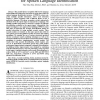Free Online Productivity Tools
i2Speak
i2Symbol
i2OCR
iTex2Img
iWeb2Print
iWeb2Shot
i2Type
iPdf2Split
iPdf2Merge
i2Bopomofo
i2Arabic
i2Style
i2Image
i2PDF
iLatex2Rtf
Sci2ools
TASLP
2008
2008
On Acoustic Diversification Front-End for Spoken Language Identification
The parallel phone recognition followed by language model (PPRLM) architecture represents one of the state-of-the-art spoken language identification systems. A PPRLM system comprises multiple parallel subsystems, where each subsystem employs a phone recognizer with a different phone set for a particular language. The phone recognizer extracts phonotactic attributes from the speech input to characterize a language. The multiple parallel subsystems are devised to capture the phonetic diversification available in the speech input. Alternatively, this paper investigates a new approach for building a PPRLM system that aims at improving the acoustic diversification among its parallel subsystems by using multiple acoustic models. These acoustic models are trained on the same speech data with the same phone set but using different model structures and training paradigms. We examine the use of various structured precision (inverse covariance) matrix modeling techniques as well as the maximum li...
| Added | 15 Dec 2010 |
| Updated | 15 Dec 2010 |
| Type | Journal |
| Year | 2008 |
| Where | TASLP |
| Authors | Khe Chai Sim, Haizhou Li |
Comments (0)

